The 2013 MacBook Air Review (13-inch)
by Anand Lal Shimpi on June 24, 2013 12:01 AM ESTThe GPU: Intel HD 5000 (Haswell GT3)
Hire enough ex-ATIers and you’ll end up really caring about GPU performance apparently. It’s good to see that Apple still views increasing GPU performance as non-negotiable, even at the MacBook Air level. Discrete GPUs are out of the question in the MacBook Air, so all models ship with Intel’s on-die processor graphics. More importantly, all CPU choices integrate the largest GPU offering: Intel’s HD 5000 (aka GT3).
Clock speeds alone prevent the 40 EU GPU implementation from being called an Iris 5100. Given the 15W TDP limit, Intel wouldn’t be able to do the Iris name justice even if it tried.
It’s hilarious that Intel refused to give out die photos for anything other than quad-core Haswell GT2, citing competitive concerns, yet at Apple’s WWDC launch of the new MacBook Airs we got to see the first die shot of a dual-core Haswell GT3. Update: I stand corrected. Intel posted its own shot here.
From the die photo it’s very obvious that like the quad-core Haswells with Iris Pro, the dual-core GT3 parts are over half GPU. Here's the only Haswell die shot Intel PR officially released by comparison, a quad-core GT2 part that's mostly made up of CPU cores:
Similar to the CPU discussion, on the GPU front Haswell has to operate under more serious thermal limits than with Ivy Bridge. Previously the GPU could take the lion’s share of a 17W TDP with 16 EUs, now it has 15W to share with the PCH as well as the CPU and 2.5x the number of EUs to boot. As both chips are built on the same 22nm (P1270) process, power either has to go up or clocks have to come down. Intel rationally chose the latter. What you get from all of this is a much larger GPU, that can deliver similar performance at much lower frequencies. Lower frequencies require lower voltage, which in turn has a dramatic impact on power consumption.
Take the power savings you get from all of this machine width, frequency and voltage tuning and you can actually end up with a GPU that uses less power than before, while still delivering incrementally higher performance. It’s a pretty neat idea. Lower cost GPUs tend to be smaller, but here Intel is trading off die area for power - building a larger GPU so it can be lower power, instead of just being higher performance.
| A Historical Look at MacBook Air GPU Performance | |||||||||
| 2011 | 2012 | 2013 | |||||||
| GPU | Intel HD 3000 | Intel HD 4000 | Intel HD 5000 | ||||||
| Manufacturing Process | 32nm | 22nm | 22nm | ||||||
| Frequency | 350/1150MHz | 350/1050MHz | 200/1000MHz | ||||||
| Cores | 12 | 16 | 40 | ||||||
| Peak GFLOPS | 165.6 GFLOPS | 268.8 GFLOPS | 640 GFLOPS | ||||||
| TDP | 17W | 17W | 15W | ||||||
This is an even bigger deal because few of the other OEMs seem interested in paying for the larger die. Acer’s S7 uses Intel’s HD 4400 (Haswell GT2, 20 EUs), as do most of the other Haswell Ultrabooks that have been announced thus far. Armed with a 2011, 2012 and 2013 MacBook Air as well as Acer’s 2nd generation S7, we now have the ability to compare everything from Intel’s HD 3000 (Sandy Bridge) all the way up to HD 5000. It’s important to keep in mind that with the exception of HD 3000, everything here is built on the same 22nm process, and with HD 4400/5000 TDPs actually went down. In other words, post Ivy Bridge, any GPU performance gains were very hard to come by.
I’m splitting up the GPU performance data into three sections. The first is a look at some games/settings that are actually playable on processor graphics. The second is comparison data for laptop Bench. The deltas here are academic at best since nothing slower than Iris Pro can really deliver playable frame rates in our high-end notebook GPU tests. The final section focuses on synthetic performance, which should help characterize the peak theoretical gains you can expect from HD 5000.
All of the gaming tests were run under Boot Camp/Windows 8. I think it’s time to retire the HL2/Portal testing under OS X.
Playable Gaming Performance
There's a surprising number of games that are actually playable on Intel's HD 5000 in the MacBook Air. You have to be ok with the fan spinning quite loudly, but it's possible to get some ultra portable gaming in if you're up for it.
For all of these tests I stuck with 1366 x 768 so I could run comparable data on the only HD 3000 equipped MBA I had, an 11-inch model. I also threw in data from Inte's HD 4400 using the new Haswell equipped Acer S7. I'll start with GRID 2, a brand new racer, running at relatively low quality settings.
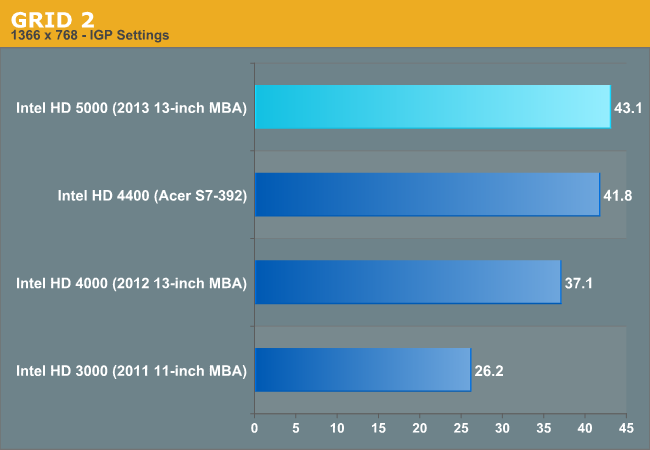
GRID 2 is absolutely playable on the new MacBook Air. At 43.1 fps it's 16% faster than last year's HD 4000 model. A 16% gain without increasing TDP on the same manufacturing process is pretty impressive. The gains over the 2011 MBA are substantial. GRID 2 goes from almost playable to fast enough where you can actually turn up some of the quality settings if you wanted to.
Next up is Borderlands 2. Again, a fairly modern title, but one that's really optimized for current generation consoles - making high-end processor graphics more than up for the task. While a higher TDP implementation of Haswell's integrated graphics wouldn't have an issue here, things are a little more difficult with a 15W TDP.
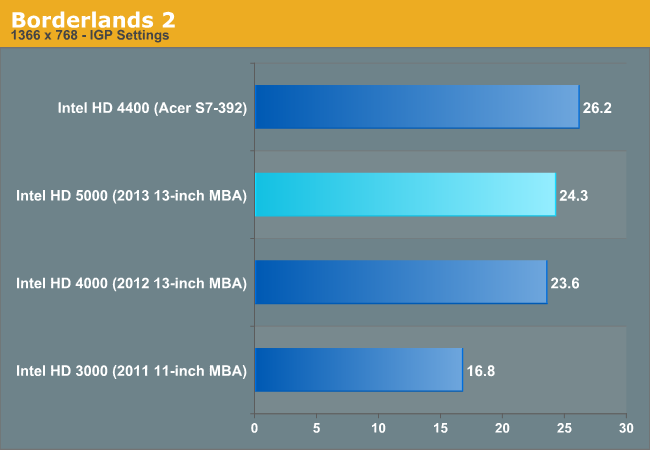
We see a marginal improvement over the HD 4000, we're clearly thermally bound at this point. What's interesting is the HD 4400 on the S7 is actually quicker here. The difference could be cooling or how Apple decides to scale back on GPU frequency when faced with thermal limits. A quick look at Haswell's power reporting confirms that while running my Borderlands 2 test the GPU was already exceeding the PL1 (Power Limit 1) of 15W:

Remember, with Sandy Bridge Intel introduced Turbo Boost 2.0 that effectively allowed for two separate power limits - one equal to the processor's TDP (PL1) and one higher than the processor's TDP (PL2) that could be hit as long as the die temperature doesn't get too high.
Despite the sub 30fps frame rate in this benchmark, Borderlands 2 was definitely playable on the HD 5000. It wasn't always smooth but if you need your single player fix, it'll suffice.
I've had a few requests to bring back our Minecraft benchmark. We ditched it from our higher end GPU reviews since it's no longer stressful enough, but for 15W TDP iGPUs it's perfect.
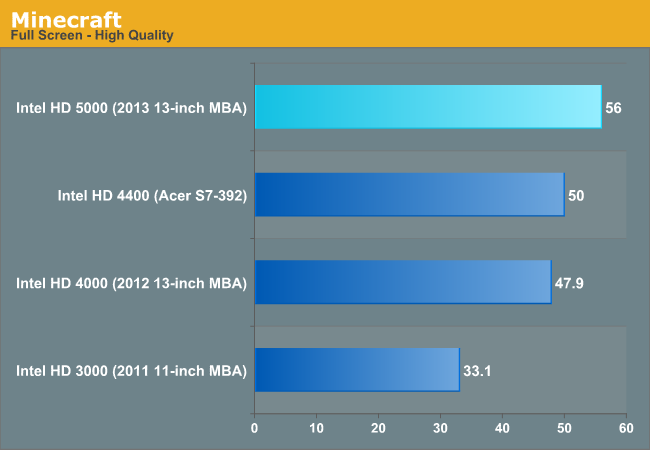
Once again we see almost a 17% increase over Intel's HD 4000. The HD 4400 comparison is also very impressive with a 12% increase in performance vs. what most MBA competitors will be using.
When I was a kid all I wanted was a console that could play arcade quality ports of Street Fighter II and Mortal Kombat II. These days, even the latest Street Fighter title has no issue playing on free graphics:
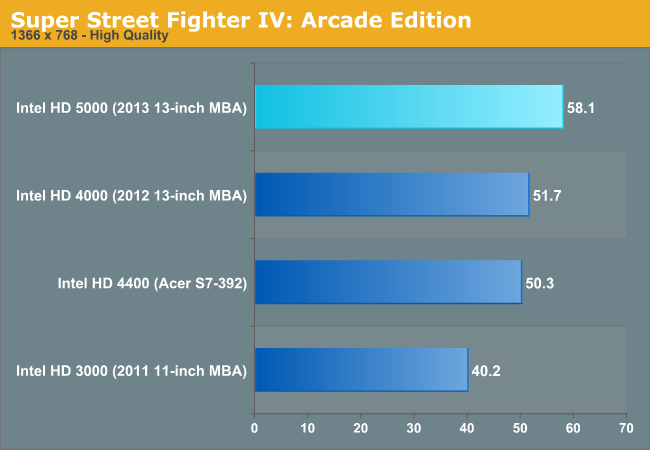
16% seems to be the magic number as that's exactly how much faster HD 5000 is compared to HD 4000. Given the lower TDP this year, that's a pretty reasonable gain. Looking at the sheer number of transistors that had to be used to get there however gives you good insight into just how hard it is to improve performance without a corresponding process node shrink.



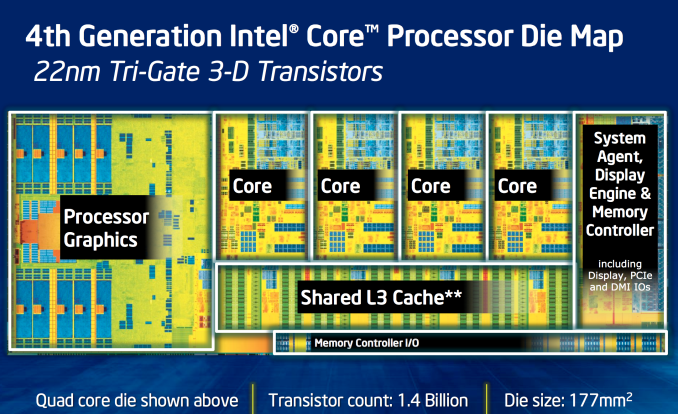
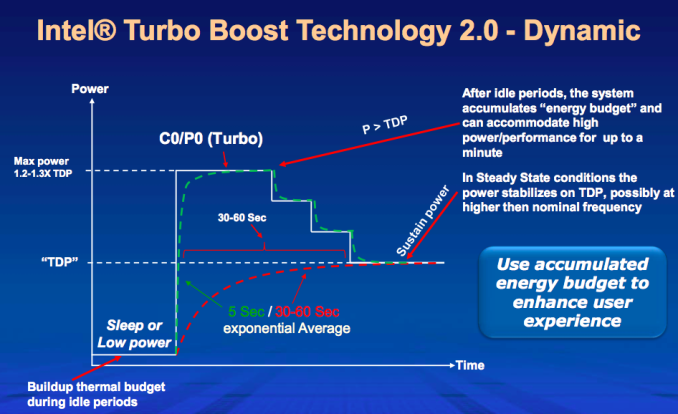








233 Comments
View All Comments
arkhamasylum87 - Monday, June 24, 2013 - link
Broadwell will have a refreshed GPU architecture and with the process shrinks, the gains would be more amenable to all. Although the intent to raise the GPU perf a decent percentage with dedicating more than the half the die is a big time change at Intel.rmr - Monday, June 24, 2013 - link
Hi Anand,Good review! I'm waiting for the updated review (using the i7 processor). BTW will it be possible for you to test the Air with an older 802.11g router (since some people have been complaining in the Apple forums about the Air dropping Wifi connections)? I was planning to get a new MBA but I'll be mostly using it at locations with older .11g routers.
Thanks.
Regards,
rmr
scyap - Monday, June 24, 2013 - link
Did the writer mention what OSX version was used for testing? Or I missed out?If this review was using Mountain Lion, should I expect even better battery life in Mavericks?
xype - Tuesday, June 25, 2013 - link
Yes, you should. Every dev I know who runs on Mavericks reports 10-20% better battery life (that's mighty subjective and unscientific, but I am sure AnandTech will do a proper test).Personally I'll make use of my dev account and upgrade as soon as all the dev tools I need are confirmed a running (homebrew-installed stuff mostly).
Ricopolo - Tuesday, June 25, 2013 - link
Anand, love your site. But your constant use of acronyms (like PCH, TDP, etc) that are non-household terms can be quite an obstacle to lay people, who are interested in gaining a bit of insight in tech development. Can you put together a glossary for these acronyms and put it in the footer or somewhere obvious?Thanks a lot.
SkylerSaleh - Tuesday, June 25, 2013 - link
PCH stands for Platform Controller Hub. It provides some needed utilities required to run the CPU correctly, such as display handling, connecting peripherals, DMI, etc. As a lay-mans example, the PCH supports the CPU's operation, similar to how your subconscious supports your operation. Taking over the responsibility of semi-voluntary/non-voluntary actions like breathing, so that you can think about other things.TDP stands for thermal design power. It is a measurement of the maximum amount of cooling that is needed to cool a chip in its worst case. As a rule of thumb, the higher the TDP, the more power the chip will use at peak. (However this is not a good measurement of power usage when idle.)
name99 - Tuesday, June 25, 2013 - link
Google shows up the obviously correct results for both of these very high in its list.If you want even cleaner and simpler results search on wikipedia.
I don't want to be a dick, but part of Anand being a fairly high-end site (including, for example, the variety of technical details which make it substantially more interesting than a Macworld or The Verge or WSJ review) is that it consists of an engineering aware community, which speaks in its natural language, just like any other community.
If you wish to be part of that community, the solution is not to complain that they use unfamiliar language, but to familiarize yourself with that language. It's not hard --- more so than ever before in the past you can learn what you need to just by scanning Google and wikipedia. And if you want to understand more details, again it's easier than its ever been before --- just look over the review articles either on this site, on Ars Technica (for the simplest introduction) or on David Kanter's Real World Tech (for the most sophisticated introductions you can probably get for free on the internet).
jb510 - Wednesday, June 26, 2013 - link
Well said. It's worth noting that even some of us very technical folks have to look up a lot of terms and acronyms reading here as the spectrum of content is so broad. However, I greatly prefer the clean without reference to terms style of AT to the cumbersome reading if copy that is interrupted constantly to define things. Unless you're reading the print edition of AT, the whole internet is just one click away.robco - Tuesday, June 25, 2013 - link
The updated Airs seem pretty sweet. I use my laptop as my primary machine, so I'll probably wait for the rMBP to get updated. I'm also curious to see how well the Iris 5100 graphics compare to the HD 5000. An IPS display would have been a nice upgrade, but I can see why Apple decided to make upgrades in other areas instead.The WiFi snafu is interesting. I'm not sure if Apple missed it, or figured it would be a while before most users would upgrade to ac and decided to go ahead and ship it in time for WWDC. As for battery life, even the numbers under heavy workload are impressive for such a small machine. I'm curious to see how well the battery life numbers improve for other ultrabooks as they switch to Haswell running different OSes. I would also like to see if or how well battery live improves after OS 10.9 is released this fall.
Abelard - Tuesday, June 25, 2013 - link
Thanks for the thorough review, Anand. The battery life you were getting is very impressive.I'm curious how the MBA will perform running OS X Mavericks, though. Developers and early adopters seem to be reporting battery life improvements. It's possible Mavericks could squeeze another hour or two out of the 2013 MBA.